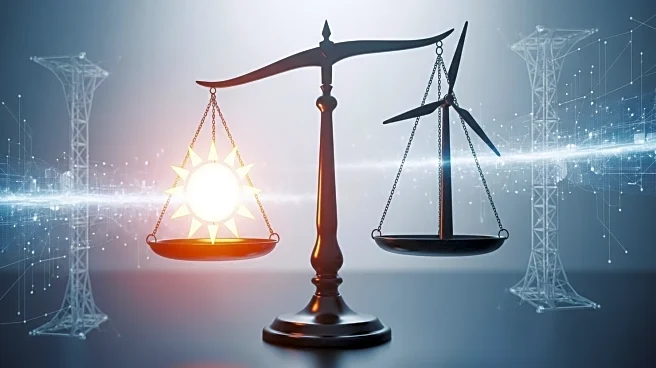What's Happening?
The U.S. power grid is undergoing significant transformation to address challenges posed by climate change, decarbonization, and increased electrification. The grid faces stress from extreme weather events, necessitating a shift from carbon-based energy sources to renewables and advanced technologies like hydrogen and next-generation nuclear power. This transformation involves decentralizing the grid to incorporate small-scale energy sources, such as rooftop solar and local wind farms, creating a network of bidirectional energy flows. The integration of sensing technology and AI-enhanced processing power is crucial for real-time data analysis and grid management, allowing utilities to respond flexibly to demand changes and prevent outages.
Why It's Important?
The transformation of the U.S. power grid is critical for ensuring resilience against climate-driven stressors and meeting the growing demand for electricity from electric vehicles and AI-capable data centers. Decarbonization efforts aim to reduce reliance on carbon-heavy fuels, promoting cleaner energy sources and sustainable grid infrastructure. The decentralization of energy generation enhances grid responsiveness and reliability, while digitalization through advanced sensing and AI technologies provides utilities with valuable insights for efficient grid management. These changes are essential for maintaining stability and supporting the reindustrialization of the U.S. economy.
What's Next?
The ongoing transformation of the power grid requires collaboration between manufacturers and utility companies to develop tailored solutions that meet specific needs. Rapid deployment of durable technologies is necessary to withstand decades of use, and a strategic approach to upgrading aging infrastructure is essential. Building lasting partnerships grounded in trust will drive meaningful innovation and accelerate progress toward a resilient, adaptive, and sustainable grid. As the grid evolves, manufacturers must remain agile to align with the changing requirements of grid operators, ensuring the development of reliable and scalable products.
Beyond the Headlines
The shift towards a decentralized and digitalized power grid has broader implications for energy policy and environmental sustainability. The adoption of eco-friendly systems and elimination of harmful substances in grid infrastructure contribute to a cleaner environment. The integration of AI and sensing technology not only enhances grid management but also sets the stage for future advancements in smart grid solutions. These developments may influence regulatory frameworks and investment strategies in the energy sector, promoting innovation and long-term resilience.











